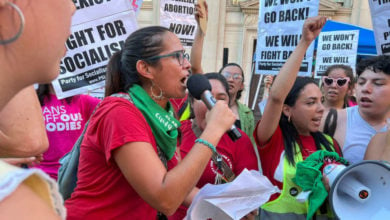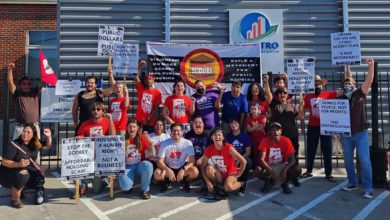Survivors of the horrific massacre at Robb Elementary School in Uvalde, Texas, that left 19 children and two teachers dead and 17 others wounded, have filed lawsuits to hold the agencies they say enabled the massacre accountable under the law.
While it was 18-year-old Salvador Ramos who ultimately pulled the trigger on May 24, survivors’ and victims’ families maintain that a range of negligent entities — including the Uvalde Police Department, the arms manufacturers and the store that sold him the deadly weaponry — played a role in enabling the destruction of so many innocent lives.
A federal law under the Bush administration seeks to shield gun manufacturers and peddlers from accountability. Police also enjoy widespread protection from the consequences of their actions through “qualified immunity” laws and their relationships with the corrupt legal system. But there have been exceptions to both sets of protections in which victims have taken the system to court and won.
Winning these lawsuits will undoubtedly be an uphill battle, but it’s a battle that the Uvalde families have decided to fight.
Hundreds of cops did nothing to stop shooting
Between May 17 and 20, beginning the day after his 18th birthday, Salvador Ramos made repeated visits to the gun store Oasis Outback. In the span of three days, he purchased a Daniel Defense AR-15-style rifle, a Smith & Wesson AR-15-style rifle, and 2,115 rounds of ammunition at a cost of $4,896.
On the morning of May 24, Ramos shot his grandmother in the face, stole her truck and drove a few blocks to Robb Elementary School, bringing the loaded AR-15 with him. After crashing the truck in a ditch, he fired his gun at two eyewitnesses who saw him heading towards the school. Within three minutes of Ramos entering the school, according to Texas Department of Public Safety Director Col. Steve McGraw, there were enough officers and firepower to stop him. They failed to intervene.
Ramos entered a conjoined set of classrooms through a door that did not lock properly. Even though students and teachers were in those classrooms with the shooter, police designated Ramos a barricaded subject as opposed to an active shooter. The police were aware of this fact, as students who were inside the classroom made desperate calls, pleading with 911 dispatchers to send help. A Texas House Committee tasked with investigating the shooting later found no evidence that police officers who learned of these calls did anything to change to an active shooter protocol or act more urgently to enter the classrooms.
There were, in all, 376 law enforcement officers on the scene representing 23 agencies — local, state and federal — including the Uvalde Police Department, Texas Department of Public Safety, Uvalde County Sheriffs, San Antonio PD, Department of Homeland Security, Uvalde school police and Border Patrol. Police who were stationed outside did nothing as community members begged them to go in and stop the shooting. Parents who tried to take action to rescue their kids were placed in handcuffs, and one father was even tasered by police.
Inside the building, police spent a significant amount of time searching for a key to open the door to the classroom instead of trying to force their way in. It turned out that neither was necessary, as the door was never locked in the first place. In the end, it would be one hour and 17 minutes from the time the shooting began before police entered the classroom and stopped the shooter. By that time, he had fired more than 100 rounds of ammunition and killed 21 people. A Texas House Committee investigation released in July found that the officers at the scene prioritized their own lives over those whose lives they were supposedly sworn to protect.
Survivors seek damages from a whole system that failed them
Survivors of the tragedy are pushing back on the system that allowed the taking of so many lives. On Nov. 28, the mother and siblings of 10-year-old Eliahna Torres, who was killed in the massacre, filed a federal lawsuit seeking an unspecified amount in compensatory and punitive damages from law enforcement agencies, the gun manufacturer and the gun seller for their role in Eliahna’s death. In the words of Eliahna’s mother Sandra Torres, “I’ve brought this lawsuit to seek accountability. No parent should ever go through what I have.”
The lawsuit targets law enforcement agencies for effectively depriving Eliahna of “access to emergency medical and rescue services and the comfort of her family — who were just outside the law enforcement perimeter — as she lay dying.” It also accuses the police of illegally seizing Eliahna, other students, and teachers by confining them in the classroom when they designated Ramos a barricaded subject.
The lawsuit seeks damages from gun manufacturer Daniel Defense for violating the Federal Trade Commissions Act when it marketed “its AR-15-style rifles to young male consumers by using militaristic imagery and video game references, by marketing on various social media platforms, and by suggesting that its rifles can be used by civilians for offensive combat-style operations against non-combatants.” It also targets the gun store, Oasis Outback, for selling Ramos thousands of dollars in weaponry despite the teen’s purportedly erratic behavior at the time of purchase.
The day after the Torres family filed their lawsuit, a $27 billion class action lawsuit was filed in an Austin federal court by the parents, teachers, and Robb Elementary staff against the Uvalde Police Department, the Uvalde School District, the Uvalde school police, the city, the Texas Department of Public Safety and various other defendants. According to the lawsuit, officers on the scene “fundamentally strayed from conducting themselves in conformity with what they knew to be the well-established protocols and standards for responding to an active shooter.” Due to the inaction, survivors now experience life-changing trauma, with children reporting nightmares in which they see the dead bodies of their fellow students. Some have reportedly threatened suicide and are afraid to be left alone.
On the same day, a separate lawsuit was filed by the same survivors and family members seeking $6 billion in damages from Daniel Defense and Oasis Outback. Similar to the lawsuit by the Torres family, the class action lawsuit goes after Daniel Defense for its militaristic marketing tactics and Oasis Outback for selling the guns and ammunition despite doubts about Ramos’s fitness to purchase the weaponry.
Holding the gun manufacturer and gun store accountable for their roles in the shooting will be an uphill battle, largely due to the Protection of Lawful Commerce in Arms Act, signed in 2005 by President George W. Bush. The law grants broad immunity to manufacturers against civil lawsuits in shootings that occur with the weapons they make.
There have been a few exceptions where families have won settlements against gun manufacturers. Families of the victims of the 2012 massacre at Sandy Hook Elementary School in Newtown, Connecticut, sued gun manufacturer Remington and won a $73 million settlement earlier this year after the Connecticut Supreme Court ruled they could sue over the marketing under state law, under exception to the federal immunity law.
With the filing of these lawsuits, the survivors’ and victims’ families in Uvalde are doing everything they can to hold the system accountable. Eric Tirschwell, the executive director of Everytown Law representing the Torres family, explained that “[t]he massacre that killed Eliahna Torres and 20 others that day wasn’t just an act of one violent, troubled young man with an assault rifle. There are several actors responsible for putting the gun in his possession and failing to protect the children he attacked.”
The victims of the massacre in Uvalde were not only failed by a few negligent individuals. They were failed by an entire system that places police officers above the confines of the law, and puts the profits of arms dealers above the sanctity of human life.





